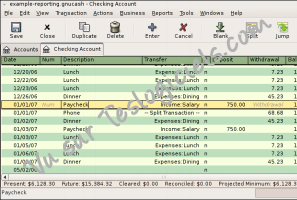
- #Gnucash for mac os how to#
- #Gnucash for mac os mac os x#
- #Gnucash for mac os install#
- #Gnucash for mac os password#
Once you stop recording, you’ll briefly see a thumbnail of the video in the lower-right corner of your screen. Or if you have a Touch Bar, you’ll see a stop button in the upper left. Or, hit command, shift, 5 and the screenshot bar will reappear with a stop button you can click. You can also hit command, control, esc to stop recording. To stop the recording, click on the little square stop button in the upper right corner of the menu bar from the top of your screen. If not, recording will begin immediately. If you’ve chosen to set the timer, you’ll see the timer counting down until the recording begins. Click the “Record button.” Or, if you’re recording the entire screen, you can simply click anywhere on the screen to start recording. Once you’ve selected the options you want, it’s time to record. You can set a countdown timer, choose which microphone to use, and decide where to save your recording, for instance. You can tell which options are for video recording, because you’ll see a little circle recording icon on the logo.Ĭhoose whether you want to “Record Entire Screen” or “Record Selected Portion.” If you choose to record only a portion of your screen, a box will show up allowing you to drag and resize the recording window.Ĭlick on “Options” to see what other preferences you can choose. You have options for grabbing a still screenshot or for recording a video. At the bottom of your screen, you’ll see the Screenshot control bar.

Press command, shift, and 5 on the keyboard simultaneously. If you have Mojave, Catalina, or a later MacOS, launching Screenshot is easy. Record your computer screen with Screenshot If you have an older Mac or just haven’t updated your operating system in ages, not to worry – you still have a fairly easy option to screen record with QuickTime. If you have macOS Mojave or a later version, you’ll be able to access this feature. The app, called Screenshot, is an easy-to-use, convenient way to save a video (and audio!) of whatever is happening on your screen. When it launched the Mojave operating system in 2018, Apple introduced built-in screen recording for the macOS (and came down hard on other screen recording apps).
#Gnucash for mac os how to#
© Provided by Mashable How to screen record on Mac Press Command + Shift + 5 on your keyboard to bring up the recording toolbar. How to record your screen on macOS Mojave Now that we know that the toolbar we used for taking a screenshot can also be used to record screen. You can use it for grabbing still screenshots. A control bar will appear at the bottom of your screen. Record your screen in macOS Mojave or Catalina Press Command + Shift + 5 to open Screenshot. Then wait for the command to finish.ĭone! You can now use GnuCash.
#Gnucash for mac os password#
So just type your password and press ENTER/RETURN key. When you type the password, it won’t be displayed on screen, but the system would accept it.

If the screen prompts you to enter a password, please enter your Mac’s user password to continue.
#Gnucash for mac os install#
Ruby -e '$(curl -fsSL )' /dev/null brew install caskroom/cask/brew-cask 2> /dev/null Press Command+Space and type Terminal and press enter/return key.App description: gnucash (App: Gnucash.app).GnuCash for Mac supports databases including PostgreSQL, SQLite3 and MySQL (backend XML).

The app can be used to keep track of all your financial operations from your bank accounts, stocks and other income and expenses. GnuCash for Mac is a powerful financial-accounting app that is designed to help you with all manner of financial related tasks.

GnuCash has versions for Windows, macOS, Linux and BSD. GnuCash is a financial management application designed to be easy to use.
#Gnucash for mac os mac os x#
GnuCash is a personal and small business finance application, freely licensed under the GNU GPL and available for GNU/Linux, BSD, Solaris, Mac OS X and Microsoft Windows. It replaced the Open Financial Connectivity format used by Microsoft Money and is now the standard container for financial information under the Open Financial Exchange Consortium. OFX is an SGML-based file format standardized in 1997 by Intuit, Microsoft, and CheckFree.


 0 kommentar(er)
0 kommentar(er)
